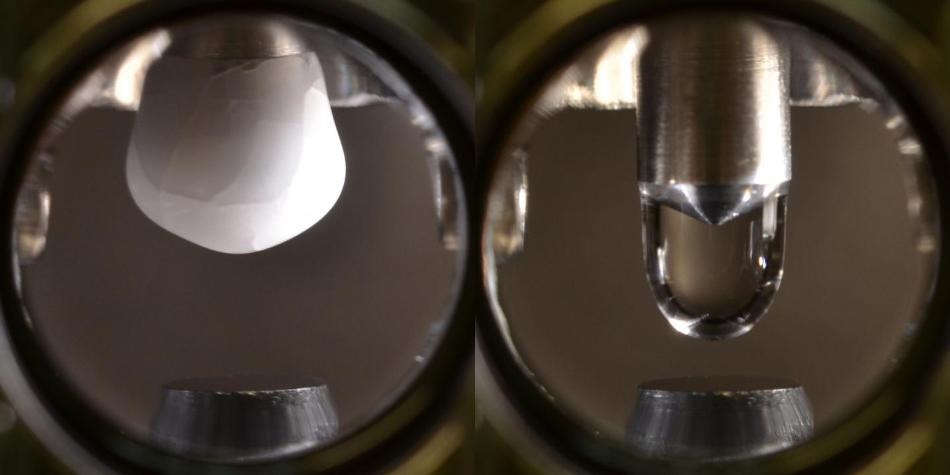Aug 27 2018
A truly clean surface does not exist in nature. A thin layer of molecules is coated on any material with a mere contact with normal air. The properties of the material can be largely affected by this “molecular dirt”; however, the molecules themselves are challenging to analyze.
 The ultraclean icicle (left) and the droplet, after melting. (Image credit: TU Wien)
The ultraclean icicle (left) and the droplet, after melting. (Image credit: TU Wien)
Some researchers have proposed that this “dirt” is merely a single layer of water molecules. In order to investigate this concept, a new testing method has been devised at TU Wien - scientists were able to produce the cleanest water drops in the world by producing ultra-pure ice in a vacuum chamber and then melting it; then, the drops were applied to titanium dioxide surfaces.
Using this technique, the scientists have demonstrated that the “dirt” that modifies the characteristics of titanium dioxide surfaces is a single-molecule-thick layer of two organic acids: acetic acid (that renders vinegar sour) and its close associate, formic acid. This is astonishing since only minute traces of these acids are found in air. These outcomes and the details of the innovative technique were recently reported in the Science journal.
Unexplained Structures
Titanium dioxide (TiO2) is an abundant mineral that has a vital role in a broad array of technical applications, such as self-cleaning surfaces. For instance, a thin titanium dioxide layer prevents fogging up of mirrors in moist air. Highly powerful microscopes were used by scientists across the globe to identify an unknown molecule attached to titanium dioxide surfaces upon coming into contact with water.
The concept has been put forward that these molecules were an innovative type of water ice or even soda water formed from carbon dioxide in the air. The correct answer is highly astonishing: the researchers discovered that these structures are originally two organic acids, formic acid and acetic acid, which are by-products of plant growth. Fascinatingly only tiny traces of these acids exist in the air—a few acid molecules per billion air molecules. Despite the fact that various other molecules are highly common in air, only these two acids attach to the metal oxide surface and alter its properties.
Ultra-Pure Water in a Vacuum
In order to avoid impurities, experiments like these have to be carried out in a vacuum. Therefore, we had to create a water drop that never came into contact with the air, then place the drop on a titanium dioxide surface that had been scrupulously cleaned down to the atomic scale.
Ulrike Diebold
This challenge was made even harder by since water drops evaporate rapidly in a vacuum, irrespective of the temperature.
The scientists devised a novel and innovative investigation technique. The solution was to form a “cold finger” in their vacuum. The metal finger’s tip is cooled to about −140 °C, and subsequently, ultra-pure water vapor is allowed to flow into the chamber. The water freezes on the tip of the cold finger and forms a small, ultra-clean icicle. Then, the titanium dioxide sample is positioned below the finger. Upon melting of the icicle, ultrapure water drops on to the sample.
Organic Acids are to Blame
Then, the surface was analyzed with the help of high-powered microscopes; however, the researchers could not find any traces of the unknown molecules using ultrapure water. The strange “dirt-layer” could not be observed even when soda water was made with carbon dioxide. This suggests that the origin of the molecules should be something other than carbon dioxide or water.
The strange molecules were found to appear only when the sample came into contact with air. Fascinatingly, the same molecules were found in various parts across the globe - in a rural part of the United States and in urban Vienna. Upon chemical analysis, they were found to be simple organic acids typically synthesized by plants.
This result shows us how careful we need to be when conducting experiments of this kind. Even tiny traces in the air, which could actually be considered insignificant, are sometimes decisive.
Ulrike Diebold
Apart from TU Wien, Cornell University (New York, USA) was also involved in the study.